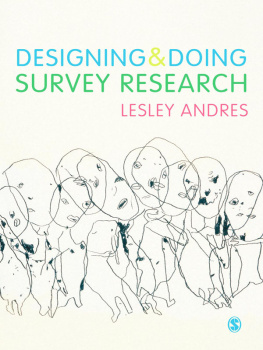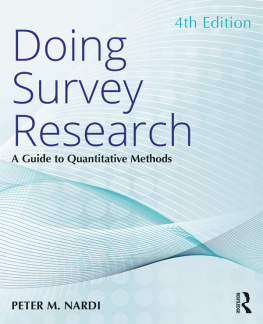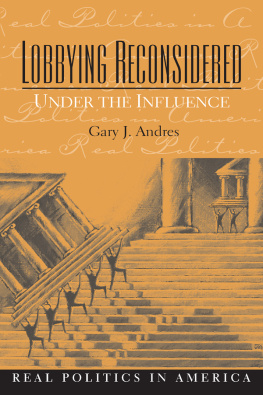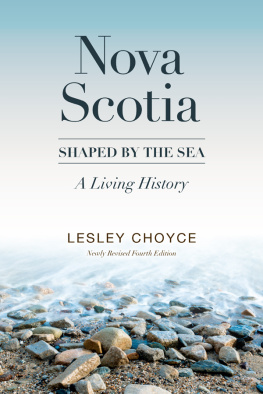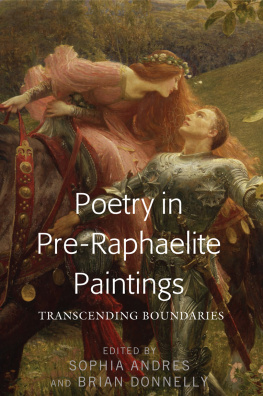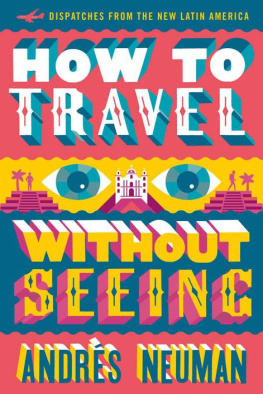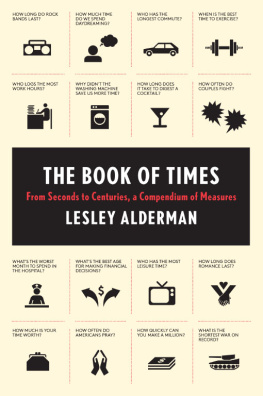DESIGNING & DOING 3 SURVEY RESEARCH
SAGE has been part of the global academic community since 1965, supporting high quality research and learning that transforms society and our understanding of individuals, groups and cultures. SAGE is the independent, innovative, natural home for authors, editors and societies who share our commitment and passion for the social sciences.
Find out more at: www.sagepublications.com
DESIGNING & DOING SURVEY RESEARCH
LESLEY ANDRES
Lesley Andres 2012
First published 2012
Apart from any fair dealing for the purposes of research or private study, or criticism or review, as permitted under the Copyright, Designs and Patents Act, 1988, this publication may be reproduced, stored or transmitted in any form, or by any means, only with the prior permission in writing of the publishers, or in the case of reprographic reproduction, in accordance with the terms of licences issued by the Copyright Licensing Agency. Enquiries concerning reproduction outside those terms should be sent to the publishers.
SAGE Publications Ltd
1 Olivers Yard
55 City Road
London EC1Y 1SP
SAGE Publications Inc.
2455 Teller Road
Thousand Oaks, California 91320
SAGE Publications India Pvt Ltd
B 1/I 1 Mohan Cooperative Industrial Area
Mathura Road
New Delhi 110 044
SAGE Publications Asia-Pacific Pte Ltd
3 Church Street
#10-04 Samsung Hub
Singapore 049483
Library of Congress Control Number: 2011939236
British Library Cataloguing in Publication data
A catalogue record for this book is available from the British Library
ISBN 978-1-84920-812-3
ISBN 978-1-84920-813-0
Typeset by C&M Digitals (P) Ltd, Chennai, India
Printed and bound by CPI Group (UK) Ltd, Croydon, CRO 4YY
Printed on paper from sustainable resources
Table of contents
About the author
Lesley Andres is a Professor in the Department of Educational Studies at the University of British Columbia. Her research and teaching interests include the sociology of education, foundations of higher education, issues of inequality and access, life course research, and quantitative and qualitative research methods.
She is the principal investigator of the Paths on Lifes Way Project, a unique Canadian longitudinal study that has combined extensive quantitative and qualitative survey data over a 22 year time frame to examine the lives, actions, and experiences of individuals within a life course framework. Her most recent book, entitled The Making of a Generation: Children of the 1970s in Adulthood (co-authored with Johanna Wyn, 2010, University of Toronto Press) is a longitudinal comparative analysis of Canadian and Australian young adults. Also, she is the editor of the Canadian Journal of Higher Education.
In 2010, she was the DAAD (Deutscher Akademischer Austausch Dienst/German Academic Exchange Service) Chair for International Comparative Studies in Social Sciences at the Bremen International School of Social Sciences, University of Bremen, Germany and Fellow at the Hanse Wissenschaftskolleg (Institute for Advanced Study), Delmenhorst, Germany.
Acknowledgements
The majority of this book was written during my tenure as the DAAD (Deutscher Akademischer Austausch Dienst/German Academic Exchange Service) Chair for International Comparative Studies in Social Sciences at the Bremen International School of Social Sciences (BIGSSS) at the University of Bremen, Germany and as a Fellow at the Hanse Wissenschaftskolleg (Institute for Advanced Study) in Delmenhorst, Germany. I extend warm thanks to Werner Dressel, Susanne Fuchs, Walter and Eva Heinz, Wolfgang Stenzel, and Ansgar Weymann for the support and encouragement they gave me during my stay. In addition, writing retreats at the Weinbau Familie Menhard allowed me to further refine the chapters within the peaceful sanctuary of the Sdsteiermark, Austria.
Numerous insightful comments offered over the years by my graduate students in my Survey Research Design course have been incorporated throughout the text. Special thanks are due to my graduate research assistant, Janine Jongbloed, for her skilled assistance and exquisite attention to detail.
In particular, I wish to thank Katie Metzler, Commissioning Editor at Sage, and Anna Horvai, Editorial Assistant, for their unflagging support, advice, assistance, and encouragement. It has been a privilege to work with the entire Sage team.
The Paths on Lifes Project, from which many of the examples included in this book have been generated, has received long-term funding from the Social Sciences and Humanities Research Council of Canada. Funding for this project has also been provided by the British Columbia Council on Admissions and Transfer.
Finally, to Hans, danke.
ONE
Survey research design then and now
On almost a daily basis, individuals are confronted with survey research either as potential participants or as recipients of results. Survey research projects are carried out or commissioned by companies, newspapers, school districts, and other organizations and are administered by individuals, governments, university researchers, polling organizations, and survey research firms. The results of survey research are reported regularly in vehicles such as scholarly research papers or government reports, or in the media ranging from the New York Times to Cosmopolitan magazine. Today, we read about the results of survey research with the purpose of informing our decisions about a range of activities such as buying a car or adopting a new fitness regime. Conversely, consumers of survey research may have been invited to participate in a survey research project because they had recently purchased a car or engaged in a particular fitness regime. According to Igo (2007: 5), today the public is simultaneously object, participant, and audience of survey research.
In general, there are two major types of survey research. Large-scale surveys such as national censuses, opinion polls, or research projects are carried out by institutions equipped with vast resources in terms of money, staff, and access to databases that are not normally available to an individual researcher. Smaller-scale surveys are carried out by institutions such as schools, post-secondary institutions, hospitals, and other organizations and individuals with the goal of gathering facts about or learning more about the demographic characteristics, behaviours, and attitudes of their students, employees, patients, clients, or members.
These large-scale sample surveys that is, those based on a representative sample of a larger population tend to employ standardized questionnaire formats with the goal of generating statistics in order to generalize to a larger population. Such surveys and their related designs are privileged in most survey methods books. Sometimes, other types of survey formats and sampling strategies are not addressed at all. Other times, a sort of schizophrenic approach is employed in survey methods books in that the topics of interviewing, non-probabilistic sampling, and open-ended questions are introduced or touched upon, but are not fully developed to the same extent as studies that are based on probabilistic designs (those employing random samples). For example, authors of many survey texts consider the group administration of a survey, for example within a classroom setting, as legitimate. However, the same authors either do not include or are critical of the convenience sample (again, students conveniently located within a classroom) as a legitimate sampling strategy. As such, these alternative approaches are usually relegated to an inferior status or condemned what Weisberg (2005: 237) calls usual textbook injunctions against [non-probability sampling]. Examples of survey research in many existing texts are based on large probability samples that are (1) not feasible for the small-scale researcher to carry out, and (2) not particularly instructive when trying to learn how to conduct survey research. The word interview in many textbooks means highly structured interviews and does not embrace the full range of uses of interviews in survey methods.




